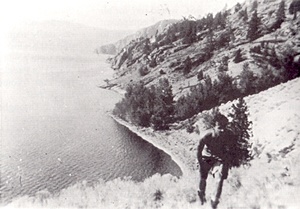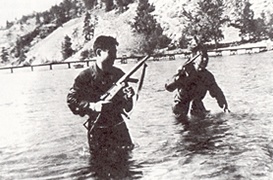Commando Bay
A special operations training camp on Okanagan Lake
During World War II, a special operations training camp was briefly established at a bay on Okanagan Lake, south of Kelowna. That bay is now known as Commando Bay in recognition of the wartime activities that took place there.
The camp at Commando Bay was part of larger scale secret warfare training and operations that had been taking place in Canada under the direction of Britain’s Special Operations Executive (SOE). A camp, known as Camp X in southern Ontario, had been in operation for some time before the Commando Bay facility was established. Many allied agents and special operations teams had been trained there for activities behind enemy lines.

Known as Force 136, they were to participate in operations in support of allied efforts in places like Malaya and Borneo where their knowledge of Chinese would be an invaluable asset in cooperation with local resistance members. The requirement for this force originated from the British Security Coordination organization of Sir William Stevenson, the man called Intrepid, a Canadian heading British Intelligence during WWII. The British desperately needed operatives with a Chinese background and came to Canada to recruit from the Chinese-Canadian population.
The Commando Bay camp operated between May and September 1944. Its graduates went on to further training in Australia and service in in India, Ceylon, Malaya and Borneo. A testament to the courage of the members of Force 136 is the fact that out of this small group, four were awarded the Military Medal for their bravery in action.
“For two decades now, our collection has wowed both locals and visitors, and we’re excited for that to continue. This is part of our shared history and a chance for us to come together in remembrance."
- Keith Boehmer, Military Historian
Make History
Or at least help preserve it. Join the Kelowna Museums Society and keep history alive through exhibitions, programming, collections, conservation, and research. Our vision is to inspire a community to be alive with its history – connecting people and place.
During WWI and WWII, women took over the work of the men, while maintaining their traditional roles at home. They ran Kelowna’s fire brigade, forming the ‘Ladies Hose Reel Team.’


